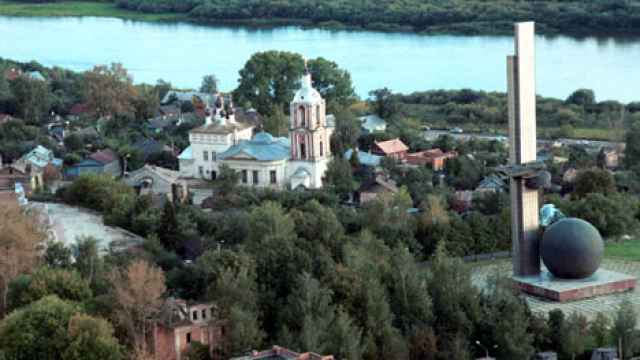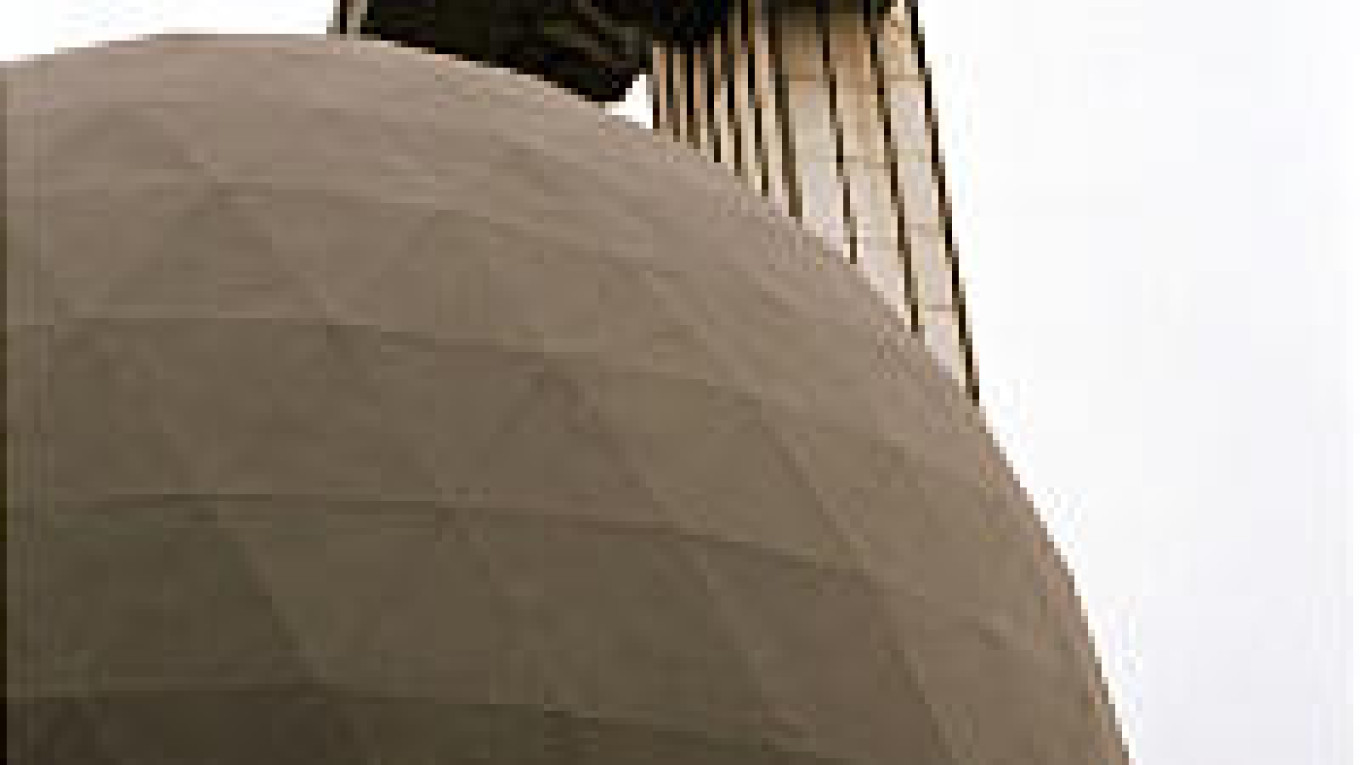The trip to Kaluga takes only three hours by bus, or 2 1/2 hours by express elektrichka, or commuter train. But in that short time you will leave behind all thoughts of Moscow's traffic jams and bustling crowds. Kaluga welcomes the harried visitor from the capital with pleasant, quiet streets and open spaces.
Your first thought upon entering Kaluga will likely be that you've taken a wrong turn and landed at a space launch facility. Kaluga is rolling in rockets, and they're all here thanks to Konstantin Tsiolkovsky (1857-1935), a schoolteacher and scientist in aeronautics and astronautics who pioneered rocket and space research. Tsiolkovsky lived in Kaluga from 1892 until his death.
On the edge of Kaluga stands Tsiolkovsky Park. The legendary scientist is buried at the center of the park, and his grave is marked by -- you guessed it -- a statue of a rocket. Tsiolkovsky was quite fond of this park during his lifetime, and one reason was likely the beautiful view that opens up from a precipice at the park's edge. From here you look out on the broad Oka River and the evergreen forest beyond.
The park also contains the Tsiolkovsky Museum of Cosmonautics History, which opened in 1967. None other than Yury Gagarin -- the first man in space -- laid the first stone for the new museum in 1961. The museum boasts Gagarin's flight journal and the cockpits of the first Soviet spaceships. In addition to exhibits on the history of space travel, the museum also contains a planetarium that offers multimedia shows and lectures to the public. Admission to the museum costs less than $1.
Nearby stands the Tsiolkovsky House-Museum, founded one year after the scientist's death. The building suffered severe damage during World War II -- as did much of Kaluga -- but it has been handsomely restored. On the way from the park to the house-museum, you pass a monument commemorating the 600th anniversary of the founding of Kaluga in 1371. The monument, built by the famous sculptor Lev Kerbel, consists of a huge sphere and pole on a massive pedestal. Kerbel is perhaps best known for his monument to Karl Marx on Moscow's Teatralnaya Ploshchad.
Among Kaluga's architectural gems is the Kamenny Bridge built across the Berezuyevsky Ravine in 1780. The bridge stands on 15 stone arches and was built entirely by hand. The town's main thoroughfare is Ulitsa Kirova, which begins at Ploshchad Mira, where you'll find a monument to -- no prizes for guessing -- Tsiolkovsky. The monument, erected in 1957, features the bronze figure of Tsiolkovsky next to an 18-meter-high steel rocket. This monument has become the symbol of Kaluga. Halfway along Ulitsa Kirova stands Teatralnaya Ploshchad, which is home, naturally, to Kaluga's main theater.
Kaluga's other main park is the Park Kultury i Otdykha, where you'll find the Trinity Cathedral, built over the course of 33 years and finished in 1819. The cathedral boasts a 70-meter-high bell tower and cupolas 17 meters in diameter. This cathedral was the final resting place of the second False Dmitry, pretender to the Muscovite throne during the Time of Troubles (1598-1613). He claimed to be Dmitry Ivanovich, the son of Ivan the Terrible who died mysteriously in 1591.
The Trinity Cathedral burned during the Patriotic War with Napoleon in 1812, but was fully restored. After the 1917 Revolution, it housed an exhibition of weapons that must have looked rather out of place in a house of worship. When the exhibition was removed, the cathedral was let out for various purposes, including flower shows. The strangest use for the cathedral was surely the training of mountain climbers who clambered up its walls on ropes. Today, the cathedral has been restored to its original purpose. Patriarch Alexy II confirmed its status as Kaluga's main Russian Orthodox church when he held a special service here in 1992.
The finest example of secular architecture in Kaluga is the late 17th-century home of the merchant Kirill Korobov. The upper and lower flowers of the house are not connected, a peculiarity of the period. The house features a special tainik, or cache, where furs and fancy clothes were stored.
You should also visit Kaluga's gostiny dvor, or shopping arcade, built at the end of the 18th and beginning of the 19th centuries. Designed in a Romantic style incorporating elements of the Gothic and traditional Russian styles, the arcade has a rather grand, unusual appearance. Looking out from the arcade you will see Kaluga's main statue of Vladimir Lenin.
 |
| Itar-Tass A view of Kaluga, featuring the monument to the city's 600th anniversary, erected in 1971, and the Church of the Veil on the Ditch. Kaluga is a must-see for fans of space exploration, and a nice getaway from Moscow. |
Where to Stay
The Priokskaya Hotel is Kaluga's most comfortable. It offers a variety of rooms, ranging in price from $18 to $43 per night. The staff is personable, and the rooms have all the necessary conveniences, even satellite TV. Telephone: (0842) 50-38-04.
If you're looking for a guided tour, try the Vizit agency, which will meet you at the station, arrange for lodging and excursions, and offers translators. Tel. (0842) 57-63-49.
Where to Eat
Try the Kaluga restaurant, located in the hotel of the same name. It looks a little iffy on the outside, but inside it's clean and pleasant. Most importantly, the menu is large and the food is great. And it's open until midnight. The Italyanskaya Pizza pizzeria is also good and cheap.
For a little night life, try the B-45 Club, which has bowling and billiards. You'll find a another reasonable club called "Bomba" nearby.
How to Get There
Express elektrichki leave Kievsky Station twice a day for Kaluga. The trip takes about 2 1/2 hours. Tickets cost $4 to $6.
A Message from The Moscow Times:
Dear readers,
We are facing unprecedented challenges. Russia's Prosecutor General's Office has designated The Moscow Times as an "undesirable" organization, criminalizing our work and putting our staff at risk of prosecution. This follows our earlier unjust labeling as a "foreign agent."
These actions are direct attempts to silence independent journalism in Russia. The authorities claim our work "discredits the decisions of the Russian leadership." We see things differently: we strive to provide accurate, unbiased reporting on Russia.
We, the journalists of The Moscow Times, refuse to be silenced. But to continue our work, we need your help.
Your support, no matter how small, makes a world of difference. If you can, please support us monthly starting from just $2. It's quick to set up, and every contribution makes a significant impact.
By supporting The Moscow Times, you're defending open, independent journalism in the face of repression. Thank you for standing with us.
Remind me later.


